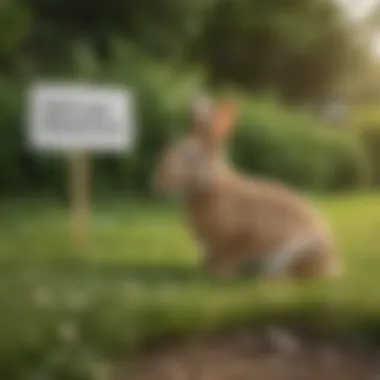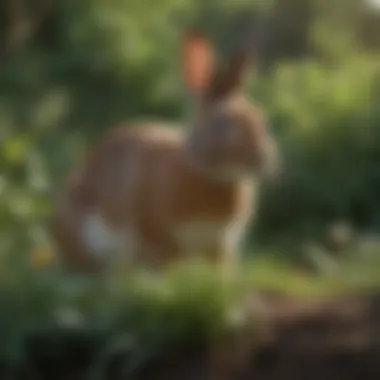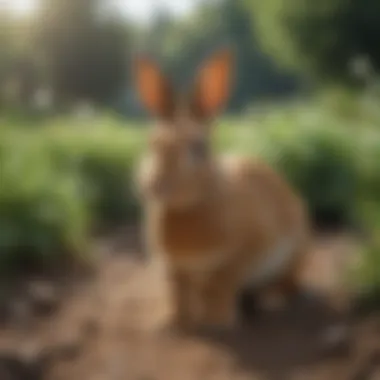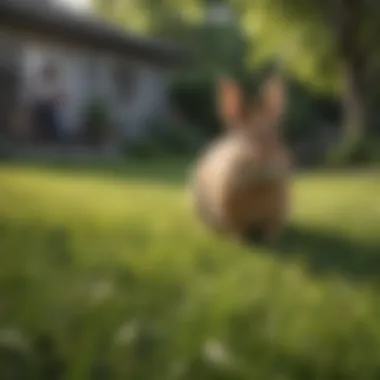Effective Strategies to Keep Rabbits Off Your Lawn


Intro
Rabbits often charm their way into gardens and lawns, leaving behind a trail of destruction. For many homeowners, these small creatures can ruin the aesthetic appeal of their outdoor spaces. To prevent this scenario, it is essential to understand the strategies that can effectively keep rabbits at bay. This article delves into various approaches, beginning with an overview of rabbits to underscore their behavior, habitat, and role in the ecosystem.
Animal Overview
Common Names
Commonly known as the European rabbit, Oryctolagus cuniculus is familiar to many. Other names like wild rabbit or domesticated rabbit also apply, depending on the context of their habitation.
Scientific Classification
The scientific classification of the rabbit includes its kingdom, Animalia; phylum, Chordata; class, Mammalia; order, Lagomorpha; family, Leporidae; and genus, Oryctolagus. This classification provides insight into their biological traits and relationships.
Geographic Range
Rabbits are found across multiple continents, primarily in Europe, parts of Asia, and North America. Their adaptability allows them to flourish in diverse environments, from urban areas to rural landscapes.
Behavior and Social Structure
Social Behavior
Rabbits are inherently social animals. In the wild, they thrive in groups, which offer protection against predators. This social structure influences how they interact and forage for food.
Communication
Rabbits communicate through a combination of vocalizations, body language, and scents. They thump their hind legs to signal danger and engage in gentle nudging to convey their affection towards one another. Understanding rabbit communication can help in developing strategies to deter them effectively.
Mating and Reproduction
Breeding season typically occurs in spring. Female rabbits can have multiple litters each year, leading to rapid population growth. This reproductive capability makes controlling their presence on residential properties crucial.
Habitat and Ecosystem
Natural Habitat
Rabbits prefer areas with ample cover such as shrubs, grasslands, and cultivated fields. They build burrows in places that provide shelter from both predators and harsh weather.
Food Sources and Diet
Rabbits are herbivores, primarily consuming grasses, clovers, and various leafy greens. Homeowners often unwittingly create an appealing menu for rabbits by maintaining lush lawns and gardens.
Role in Ecosystem
Rabbits play a vital role in their ecosystems. They serve as a food source for larger predators and contribute to plant growth through their grazing habits, which helps maintain certain vegetation balances.
Understanding rabbit behavior and ecology is key in creating effective deterrent strategies.
As we consider ways to keep your lawn rabbit-free, it becomes essential to integrate knowledge about these creatures and their lifestyles. The next sections will explore practical strategies for preventing rabbits from invading your outdoor spaces, ensuring your garden remains both beautiful and protected.
Understanding Rabbit Behavior
Understanding the behavior of rabbits is crucial for effectively designing strategies to keep them off your lawn. Rabbits are peculiar creatures with unique patterns and habits that significantly influence their interactions with suburban landscapes. Recognizing these behavioral traits enables homeowners to adopt more targeted and efficient deterrent measures. Moreover, this knowledge provides insight into how to modify your lawn in a way that makes it less appealing to these animals, ultimately preserving the aesthetics of your outdoor space.
Behavioral Patterns


Rabbits are generally crepuscular. This means they are most active during dawn and dusk. Their foraging schedules influence the timing of preventative measures that homeowners should consider. During these hours, rabbits leave their burrows to search for food, making their presence more noticeable.
Additionally, rabbits are social animals, relying on communal behavior when it comes to foraging and avoiding predators. They often communicate through a series of soft vocalizations and postures. This social structure can be beneficial to understand, as it aids in predicting their movements and interactions. For instance, if one rabbit feels threatened, it may alert others in the area, resulting in a rapid retreat or a collective search for food elsewhere.
Feeding Habits
Rabbits have a herbivorous diet mainly consisting of grass, clover, and various other types of foliage. They prefer tender greens and will often target young, succulent plants. This preference impacts the types of vegetation that homeowners may want to protect or remove. Knowing what rabbits will typically eat can help individuals implement preventative measures that discourage unwanted grazing.
Rabbits have a habit of nibbling on grass but can also damage plants by digging and uprooting them in search of their preferred food. Observing areas where rabbits have grazed can provide valuable insight into which plants are particularly attractive to them. This knowledge allows homeowners to make informed decisions about plant selection and protection methods.
Habitat Preferences
A rabbit's habitat choice is largely influenced by the availability of food, shelter, and security from predators. They tend to create nests in dense vegetation or areas with ample cover, providing a sense of safety. Understanding these preferences is significant because a well-maintained yard could unknowingly offer an ideal environment for rabbits.
Moreover, rabbits prefer places with a good amount of moisture. If your lawn contains puddles or water features, it may be more appealing to them. Therefore, being mindful of the landscape's layout and making adjustments, such as relocating water containers or modifying garden layouts, can help in minimizing rabbit attraction.
“By focusing on the natural behaviors of rabbits, homeowners can create environments that are far less inviting for these animals.”
In summary, a thorough understanding of rabbit behavior, particularly their patterns, feeding habits, and preferred habitats, is essential for developing effective strategies to keep them off your lawn. This foundation creates a proactive approach rather than a reactive one, allowing for more sustainable solutions to maintain your lawn's beauty.
Identifying Attractive Features of Your Lawn
Understanding what attracts rabbits to your lawn is crucial for implementing effective strategies. Rabbits are drawn to environments that provide shelter, food, and water. By recognizing and modifying these appealing elements, you can significantly reduce the likelihood of rabbits making your lawn their home.
Types of Grass and Vegetation
The composition of your lawn directly influences its attractiveness to rabbits. Soft grasses and tender young plants are particularly appealing to these animals. Common grass types that attract rabbits include Kentucky bluegrass and fescue. They tend to prefer lush, green, and well-kept lawns that offer ample foraging opportunities.
To minimize appeal, consider choosing grass varieties that are less palatable to rabbits. Alternatives like zoysia grass or Bermuda grass may be less attractive. Additionally, incorporating diverse plant species can create a less favorable environment for rabbits.
Benefits of Understanding Plant Preferences
- Reduction in Foraging: Knowing which plants attract rabbits allows you to replace them with less appealing options.
- Enhanced Lawn Health: Implementing rabbit-resistant vegetation can contribute to a healthier, thriving lawn.
Shelter and Hiding Spots
Shelter is essential for rabbits. They seek places to hide from predators. Dense shrubbery, tall grass, and unused garden beds provide safe havens for rabbits. When these areas are present, your lawn becomes an inviting space for them to rest and reproduce.
To deter rabbits, you may want to trim overgrown plants and remove unnecessary clutter. This reduces the potential hiding spots that rabbits could use, making your lawn less appealing.
Considerations for Managing Shelters
- Trim Back Overgrowth: Regular maintenance of shrubs and gardens can help limit rabbit habitats.
- Clear Clutter: Removing piles of debris or tall weeds can eliminate areas where rabbits might seek cover.
Water Sources
Water is a critical resource for any wildlife, and rabbits are no exception. Access to water sources, whether through open containers, bird baths, or puddles, can encourage rabbits to frequent your lawn. If your lawn provides easy access to drinking water, it increases the chance of rabbits finding shelter and food nearby.
Mitigating Water Sources
- Secure Containers: Ensure all water containers are covered or difficult for rabbits to access.
- Drain Standing Water: Regularly check for and eliminate standing water that may attract rabbits to your property.
By understanding the attractive features of your lawn, homeowners can implement targeted strategies to minimize the appeal to rabbits. This proactive approach helps in preserving the aesthetics of your outdoor spaces while discouraging unwanted wildlife.
Effective Deterrents to Keep Rabbits Away
To maintain a lawn free of rabbits, utilizing effective deterrents is crucial. These strategies not only protect your landscape but also contribute to the overall balance of the ecosystem in your yard. Each method has its own strengths, addressing the rabbits' instincts and habits. Understanding these deterrents allows homeowners to choose the best options suited for their specific needs and environments.


Physical Barriers
Fencing Solutions
Fencing is often regarded as one of the most reliable methods to keep rabbits away. The critical aspect of fencing solutions is their physical presence, creating a clear boundary that rabbits cannot cross. A key characteristic of fencing is the height and type of material used. For example, a fence should be at least three feet tall and buried a few inches underground to prevent rabbits from burrowing underneath. This choice is beneficial because it provides a durable and long-lasting solution.
However, there are unique features to consider. For instance, using welded wire or similar materials are advantageous as they are sturdy and often resistant to wear. On the downside, when improperly installed, fencing can become an eyesore and may require ongoing maintenance to remain effective.
Netting Techniques
Netting techniques offer another route to deter rabbits. This method involves covering vulnerable plants or areas with mesh or netting. The key characteristic here is the lightweight and flexible nature of netting, allowing it to be easily applied and removed. It is a popular choice for protecting garden beds and young plants.
A unique feature of netting is its accessibility. It can be found in various thicknesses and forms, making it suitable for different environments. However, its disadvantages include susceptibility to wind and wear over time, necessitating regular checks and replacements. Overall, netting is a practical yet temporary solution that can be highly effective when used correctly.
Chemical Deterrents
Chemical deterrents consist of substances that emit strong odors or tastes that are unappealing to rabbits. These products can be either commercial sprays or homemade mixtures. Their effectiveness relies on the rabbits' acute sense of smell, as strong scents like garlic or predator urine can signal danger. Homeowners must consider the environmental impact of these chemicals, ensuring they do not harm other wildlife or pets. Additionally, the proper application is essential; rain and weather can diminish their potency, requiring frequent reapplication to maintain effectiveness.
Natural Remedies
Natural remedies are alternative options that can deter rabbits without adverse effects on the environment. Common natural deterrents include sprinkling cayenne pepper or using coffee grounds around the garden. These not only create unfavorable conditions for rabbits but also maintain a garden’s ecological integrity.
The appeal of such methods lies in their easy accessibility and minimal cost. However, their effectiveness can vary significantly based on the local rabbit population and environmental conditions. Homeowners should experiment with various remedies, keeping in mind that consistency is often key to long-term success.
Effective deterrents for rabbits require a combination of strategies to be fully effective. Each method contributes to creating an unwelcoming environment for these creatures.
Implementing Maintenance Practices
Implementing maintenance practices is crucial in maintaining a rabbit-free lawn. Consistent care not only ensures the aesthetic appeal of your outdoor space but also minimizes the features that attract rabbits. Regularly maintaining your lawn involves observing and acting upon various details that can either invite or deter these animals. By being proactive, you can significantly reduce the likelihood of rabbits becoming a nuisance.
Regular Lawn Care Routines
Having a well-maintained lawn is a key factor in keeping rabbits at bay. Regular lawn care routines should include mowing, fertilizing, and watering in a manner that promotes robust grass growth. An overgrown lawn can provide shelter for rabbits, making it an inviting habitat. Therefore, maintaining the grass at an optimal height can help in minimizing their presence.
In addition to mowing, it's essential to apply fertilizers judiciously to keep the grass healthy without attracting rabbits. Some fertilizers can inadvertently draw them in by creating a rich environment for their preferred food sources. Moreover, during watering, focus on sufficient hydration but avoid creating puddles or muddy spots that might appeal to them as drinking sources.
Regular Maintenance Schedule
- Mow the lawn regularly: Set a schedule to mow every 1-2 weeks during the growing season.
- Use a rake: Remove clippings and debris. This action prevents hiding spots.
- Fertilize smartly: Opt for organic options that don't enhance the flavor of grass and other plants.
By ensuring that your lawn is neat and tidy, it can help dissuade rabbits from making it their home.
Proper Waste Management
Another essential aspect of maintaining a rabbit-free lawn is proper waste management. Yard waste, such as fallen leaves, grass clippings, and food scraps, can easily attract not just rabbits but other wildlife as well. Keeping waste to a minimum and managing it effectively will limit food sources for these animals.
Effective Waste Management Practices
- Compost responsibly: Use a composter to manage organic materials. Ensure that it’s contained and will not attract rabbits.
- Dispose of leftover food: Do not leave pet food or fallen fruits unattended in your yard.
- Keep the yard clean: Regularly pick up waste and debris to deter visits from rabbits.
By focusing on cleanliness and strategic waste management, you can further discourage rabbits from frequenting your outdoor spaces.
Proper maintenance not only beautifies a lawn but also fortifies it against unwanted pests like rabbits. Regular care routines combined with thoughtful waste management create an uninviting environment for these critters.
In summary, implementing consistent maintenance practices is an essential strategy for keeping your lawn rabbit-free. By focusing on regular lawn care routines and effective waste management, you can minimize attractive features that draw rabbits, creating a healthier, more enjoyable outdoor space.
Alternative Landscaping Options


Alternative landscaping options play a crucial role in deterring rabbits from your lawn. By carefully selecting the plants and designing your outdoor space, you not only reduce the appeal for these animals but also create a more sustainable and aesthetically pleasing environment. Implementing these strategies can significantly minimize rabbit presence while enhancing the biodiversity of your garden.
Choosing Rabbit-Resistant Plants
Selecting plants that are naturally unappealing to rabbits is fundamental in retaining an untouched lawn. Many common plants, such as certain types of vegetables and ornamental shrubs, are attractive to these animals. On the other hand, choosing rabbit-resistant species, like lavender, rosemary, and marigolds, can discourage them from entering your yard.
Here are some key considerations:
- Plant Variety: Include a diverse selection of rabbit-resistant plants. This will not only improve your garden's resilience but also customize its beauty.
- Texture and Taste: Plants with strong scents or bitter tastes are often less attractive. Herbs like sage and thyme can serve dual purposes as culinary ingredients and deterrents.
- Native Species: Often, native plants have natural defenses against local herbivores, including rabbits. Research what is endemic in your area and consider incorporating these varieties into your landscape design.
Creating a Wildlife-Friendly Environment
While deterring rabbits is important, creating a wildlife-friendly environment can support overall ecosystem health. By fostering a diverse habitat, you can attract beneficial animals which contribute positively to your yard.
Consider these aspects:
- Habitat Diversity: Incorporating features such as flower beds, shrubs, and small water features can attract predatory birds and other wildlife. These animals may help keep the rabbit population in check.
- Mulching and Ground Cover: Using organic mulch not only enriches the soil but also provides cover for beneficial insects and discourages rabbit activity. Plants like clover can create a beneficial ground cover that is less appetizing to rabbits compared to fescue or other common grasses.
- Shelter Creation: Allowing for areas of denser vegetation can provide essential shelter for various wildlife, which may deter rabbits. However, ensure those areas are not overly appealing for rabbits themselves.
Ultimately, adopting alternative landscaping options means accepting a holistic approach to garden management. By creating an environment that is sustainable and less attractive to rabbits, you can improve not just the health of your lawn but also the broader ecosystem.
Monitoring and Adapting Your Strategy
Monitoring and adapting your strategy to keep rabbits off your lawn is crucial for long-term success. This process allows you to evaluate the effectiveness of your current methods, making necessary adjustments based on observed results. Rabbits are adaptive creatures, so what works initially may become less effective over time. Regular assessment keeps your approach relevant and efficient.
When implementing strategies for rabbit deterrents, it is vital to track changes in rabbit activity and lawn condition. Observing behavioral trends can help identify what aspects of your lawn attract these animals. By understanding these patterns, you can refine your efforts and enhance your deterrents.
Observation Techniques
Observation techniques play a significant role in monitoring your strategy. Start by noting the times rabbits are most active in your yard. This usually occurs during dawn and dusk. Set up a routine for observation, perhaps using a notebook or a digital tool to record your findings.
Consider observing the following:
- Rabbit Presence: Is there consistent evidence of rabbits, such as droppings or nibbled plants?
- Feeding Zones: Are there specific areas of your lawn that attract rabbits more than others?
- Patterns of Movement: Do they follow particular paths, or do they seem to enter your lawn from specific locations?
Using trail cameras can be useful. These devices can help you capture images or videos of rabbits without disturbing their behavior. This information provides insight into effective deterrent strategies.
Feedback Loop for Improvements
Creating a feedback loop for improvements is vital in achieving a successful outcome. After gathering observations, analyze the information to identify trends or successful strategies that may require reinforcement.
A solid feedback loop involves:
- Regular Review Meetings: Set intervals to discuss your findings.
- Adjust Deterrent Methods: If a particular barrier is ineffective, consider altering its height or materials.
- Evaluate Plants: If rabbits continue showing interest in certain plants, you may need to replace them with less attractive options.
Integrating feedback loops not only ensures more effective results but encourages a proactive approach to lawn maintenance. Monitoring and adapting your strategy can significantly improve your chances of maintaining a rabbit-free lawn.
Keeping a detailed record of rabbit activity equips you with knowledge that enables informed decision-making in your ongoing efforts.
Epilogue
In this article, we discussed various strategies to deter rabbits from residential lawns. Understanding the importance of a well-maintained outdoor space cannot be overstated. A rabbit-free lawn not only enhances the aesthetic appeal of your property but also preserves the integrity of your plants and landscaping.
One primary element of our discussion revolved around comprehending rabbit behavior. Recognizing their feeding habits, habitat preferences, and the types of attractions they seek allows homeowners to take more informed steps towards prevention. By noting these aspects, one can effectively minimize the lawn's allure to rabbits.
The introduction of effective deterrents plays a crucial role as well. Physical barriers such as fencing and netting can significantly reduce the chances of rabbit invasions, while chemical and natural remedies serve to reinforce these preventative measures. Varying strategies ensures that even the most persistent rabbits can be managed effectively.
Moreover, regular maintenance practices must not be overlooked. By adhering to a solid routine of lawn care and waste management, homeowners can further discourage rabbits from taking up residence on their properties. An attractive lawn is often one that shows signs of care and attention, which can be vital in deterring wildlife.
Additionally, exploring alternative landscaping options, including rabbit-resistant plants, allows for a more sustainable approach in creating a less enticing environment for rabbits. Choosing such plants not only keeps your garden thriving but also nurtures a healthier ecosystem.
Monitoring your efforts and adapting strategies based on observed outcomes is essential. By staying proactive and responsive, individuals can optimize their approaches and tailor methods specifically to their unique circumstances.
Every aspect discussed contributes towards achieving the ultimate goal: a rabbit-free lawn. By synthesizing the information, it is clear that raising awareness through education, experimenting with various strategies, and monitoring developments are key to forming a successful plan. This comprehensive guide serves as a foundation for anyone wishing to maintain an outdoor space that is both beautiful and free from unwanted rabbit visitors.







